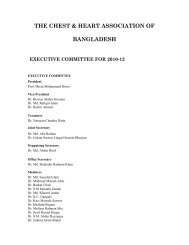Volume. 35, No. 2 july. 2011 - The Chest and Heart Association of ...
Volume. 35, No. 2 july. 2011 - The Chest and Heart Association of ...
Volume. 35, No. 2 july. 2011 - The Chest and Heart Association of ...
Create successful ePaper yourself
Turn your PDF publications into a flip-book with our unique Google optimized e-Paper software.
<strong>Chest</strong> & <strong>Heart</strong> Journal Vol. <strong>35</strong>, <strong>No</strong>.-2, July <strong>2011</strong>these trials, patients had had asthma for at leastone year <strong>and</strong> required treatment with inhaledcorticosteroids. All patients had at least onepositive skin test to a perennial aeroallergen(specifically, dust mites, cockroaches, or dog or catd<strong>and</strong>er), as well as an elevated total serum IgElevel. During the course <strong>of</strong> each trial, inhaledcorticosteroids were initially maintained at a stabledose, followed by a phase <strong>of</strong> dose reduction to thelowest dose required for asthma control. 6,7,8<strong>The</strong>se trials all demonstrated a clinical benefit fromOmalizumab, although the specific findings varied.Three <strong>of</strong> the trials evaluated patients withmoderate-to-severe persistent asthma (requiringdoses <strong>of</strong> inhaled Beclomethasone, or its equivalent,ranging from 168 to 1200 ìg per day). Two <strong>of</strong> thesethree trials included adolescents <strong>and</strong> adults, <strong>and</strong>one was a study <strong>of</strong> children 6 to 12 years <strong>of</strong> age. Inthese three trials, treatment with Omalizumab ascompared with placebo was associated withsignificantly fewer exacerbations <strong>of</strong> asthma perpatient, <strong>and</strong> a significantly lower percentage <strong>of</strong>patients had an exacerbation. In addition, the dose<strong>of</strong> inhaled corticosteroids required to controlsymptoms was significantly less among patientstreated with Omalizumab than among those whoreceived placebo. 6<strong>The</strong> fourth trial evaluated patients with moresevere asthma who required high-dose inhaledcorticosteroids for symptom control (Fluticasone,e”1000 ìg per day). In this trial, no significant effecton the frequency <strong>of</strong> exacerbations was seen,although the dose <strong>of</strong> inhaled corticosteroidsrequired to control symptoms was significantlylower among patients treated with Omalizumab. 6A fifth clinical trial involved patients who requiredat least 1000 ìg per day <strong>of</strong> inhaled Beclomethasoneplus a long-acting bronchodilator for symptom control.<strong>The</strong> study demonstrated a decrease in the rate <strong>of</strong>exacerbations <strong>of</strong> asthma only after adjustment foran imbalance in the number <strong>of</strong> exacerbations in theyear before enrollment. Among several secondaryoutcomes in these trials, quality-<strong>of</strong>-life measuresst<strong>and</strong> out as being notably improved. 6,7,8,9Considerations for IgE blocker <strong>The</strong>rapy• Patient at least 12 years <strong>of</strong> age• Evidence <strong>of</strong> reversible disease (such as 12% orgreater improvement in FEV1 with at least a200-ml increase or 20% or greater improvementin PEF)• IgE level e” 30 IU/ml• Evidence <strong>of</strong> specific allergic sensitivity (i.e.,positive skin test or blood test for IgE)• Inadequately controlled Asthma despite mediumdose <strong>of</strong> inhaled corticosteroids for at least threemonths in combination with a trial <strong>of</strong> long-actinginhaled beta2 agonists or a Leukotrienemodifier• Systemic corticosteroids or high-dose inhaledcorticosteroids required to maintain adequatecontrol• As directly observable therapy in patients whoare not adherent to prescribed therapyClinical Use<strong>The</strong> role <strong>of</strong> Omalizumab in the management <strong>of</strong>asthma has not yet been precisely defined. Patientswith persistent asthma (defined as asthma withsymptoms that occur more than two days a weekor nocturnal symptoms that occur more than twicea month 9,10 have several treatment options inaddition to the use <strong>of</strong> inhaled â-adrenergic agonists.<strong>The</strong>se include environmental control (i.e., theelimination or minimization <strong>of</strong> exposure toaeroallergens), pharmacologic control (i.e., the use<strong>of</strong> inhaled corticosteroids, Leukotriene modifiers,or both), <strong>and</strong> possibly, immunologic control (i.e.,immunotherapy for relevant antigens). In addition,evaluation for coexisting conditions such as allergicrhinitis, sinusitis, <strong>and</strong> gastroesophageal refluxdisease may prove beneficial.Patients who are particularly likely to benefit fromthe use <strong>of</strong> Omalizumab include those with evidence<strong>of</strong> sensitization to perennial aeroallergens whorequire high doses <strong>of</strong> inhaled corticosteroids thathave a potential for adverse side effects, those withfrequent exacerbations <strong>of</strong> asthma associated withunstable disease, <strong>and</strong> possibly, those with severesymptoms related in part to poor adherence todaily medication. Analyses <strong>of</strong> pooled data frompublished clinical trials have indicated that patientswho had a response to Omalizumab had a ratio <strong>of</strong>observed to expected forced expiratory volume inone second (FEV1) <strong>of</strong> less than 65%, were takingdoses <strong>of</strong> inhaled corticosteroids equivalent to morethan 800 ìg <strong>of</strong> Beclomethasone dipropionate per122



